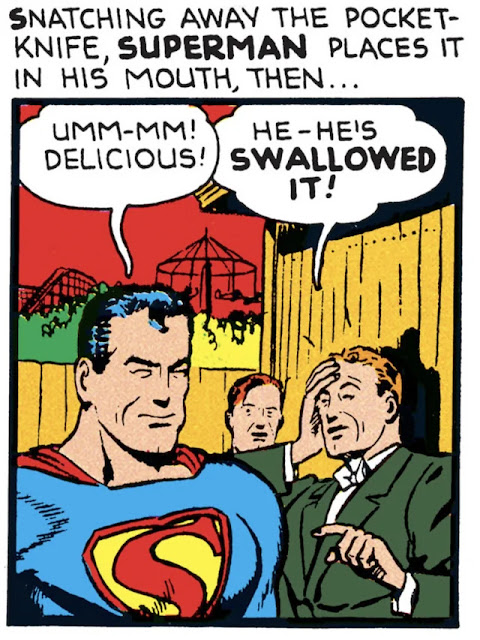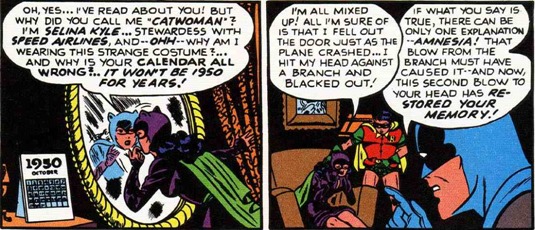Well, not DEAD. U.S. currency is never sunset and can always be used as legal lender. But, finally, the U.S. has decided no longer to mint new pennies.
It's a logical decision I have long advocated myself. Pennies, and the amount they represent, are a nuisance in modern-day commerce or, at best, superfluous. They cost, I'm told, three times as much to make as their value. And we already have gazillions of pennies in circulation, busy, well, not circulating, since their number far exceeds the supply needed nowadays.
I rejoice for this sensible, realistic decision. But, oh, how I weep for its implications for Joe Coyne, the Penny Plunderer! What would HE say?!
 |
| Something like that, I'm sure. |
The Penny Plunderer is a favorite, not just on this blog, but across the comicsphere. Although a one-off Batman foe, he was, ostensibly, saved from obscurity by the fact that the trophy from his adventure, The Giant Penny, is one of three most consistent and conspicuous of the Trinity of Trophies that identify the Batcave as not just any other hole in the ground.
 |
| It's why that penny is always drawn as a 1947 wheat-back penny; that is the year of its origin. |
 |
| I mean... it has its OWN Heroclix figure, for goodness sake. |
I myself, however, think Joe Coyne's continued cultural currency goes deeper than that. His fame comes not merely from his association with Batman's most prominent trophy, but from what he represents. The Giant Penny itself represents all of Batman's Golden Age history. Palling around with Robin, the giant props era of Gotham City, and near-deadly confrontations with gangsters and thugs who are little more than barely amped up burglars. It represents Batman's (comparatively) humble Golden Age roots, which anchor the character in a way no outer space adventure or world-saving omni-competence ever can. Whatever else he is or becomes, Batman in STILL a guy you could knock off a giant postage stamp replica with a well-thrown roll of pennies, if you got lucky.
 |
| As opposed to SOME people, who would simply SWALLOW them. |
Just as the Giant Penny represents Batman's Golden Age adventures and all their wacky glory, so does The Penny Plunderer represent an entire class of foe, the Thematic Criminal.
In the early days of comics, many crimefighters mostly just fought, well, criminals. Guys in ties, armed with guns. Golden and even Silver Age comics are FULL of them.
 |
| For example, the Martian Manhunter, even with his fantastic overage of powers, often just fought Guys In Ties. |
Or, sure, some of them might have a "angle" or even a "gimmick". But they themselves were completely unmemorable.
 |
| And for some heroes that was challenge enough. |
Supervillains, with their colorful origins, codenames, costumes, weaponry, and fixations, were very much the exception, rather than the rule. But between the Guys In Ties and the Supervillains, both chronologically and conceptually, were the Thematic Criminals. Guys like Rocky Grimes, The Blaze, The Octopus.
 |
| Like Ed Peale, a.k.a "The Gong". He rebelled against bells; a severely disproportionate reaction to a common feature of society. |
You can spot these guys a mile away. A prophetic real name; an over-reaction to some frustration for a backstory; a decision to adopt their fixation as their "crime symbol"; a thematic codename, outfit, weaponry, and, sometimes, choice of target.
 |
| It's a sure-fire formula, still in use! |
Such characters literally SHOW you, within the story itself, the transition of a Guy In Tie to a, well, if not a "supervillain", at least a "super-criminal".
 |
| They were ALWAYS called "super-criminals" on the Batman TV show. NEVER "supervillains" or even "villains". |
The "United Underworlders" up there are interesting examples. Each of them got "retrofitted" to be part of this pattern. The Catwoman, originally just a thief and schemer, got a backstory where she was an airline stewardess who got amnesia in a plane crash, remembering only a vague affinity for cats from having grown up in a pet store.
 |
| Batman #62 (1950). Just to prove I didn't make something that stupid uo. |
 |
| Detective Comics #168 (1951). Just to prove I didn't make something that stupid up. |
As a later-introduced character (1948), The Riddler largely fit the mold already. But even he has his story "deepened" to make his riddling an obsession rather than mere vanity, as it originally was.
 |
| Batman #179 (1966). Just to prove I didn't make something that stupid up. |
Even the Penguin, who was always just a pompous murderous snot, eventually accreted a more humanizing backstory to account for his various eccentricities.
 |
| A process which actually began HERE, in the Batman newspaper strip (February 17, 1946). Just to prove I didn't make something that stupid up. |
Batman's other Great Golden Age Villains, Two-Face and the Scarecrow, fit the pattern from the start. as previously discussed. In fact, one of the reasons for the longevity and utility of Batman's golden villains is that while they CAN follow the pattern when the author wants, they can just as easily DEPART into some other venture (with a different theme or no theme at all). Since these characters predate their own thematic fixations, they seem just as valid without them. The Penguin or the Catwoman can embark on a series of criminal endeavors that have nothing at all to do with cats or birds, and we don't think twice about it.
This is not true of the Purely Thematic Criminals. The Gong is unappealing without bells, Rocky Grimes must travel a rocky road, and the Penny Plunderer would be short-changed without pennies.
 |
| It is not for nothing that Joe Coyne is the perfect and enduring symbol of thematic criminal obsession and is its prime representative on TVTropes. |
But perhaps, ironically, society's dismissal of the penny is the most thematic outcome at all. After all it was the niggling and nugatory nature of pennies that set Joe off in the first place:
Joe felt that he, like the penny, was treated as valueless and tossed away, unloved, in a jar. The fact that we can no longer be bothered to mint pennies is just the logical end of the story.
Just as Joe Coyne being undone by his obsession and the uselessness of pennies,
was the logical end of HIS story.The Penny may be dead, but I say,
LONG LIVE THE PENNY PLUNDERER.
 |
| Figuratively, I mean. |












